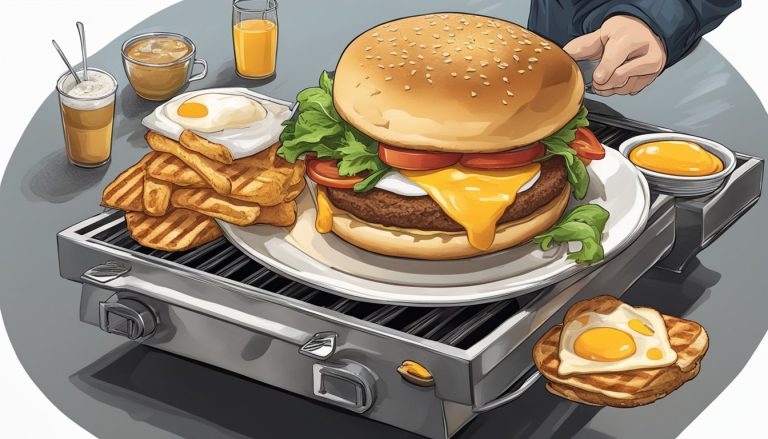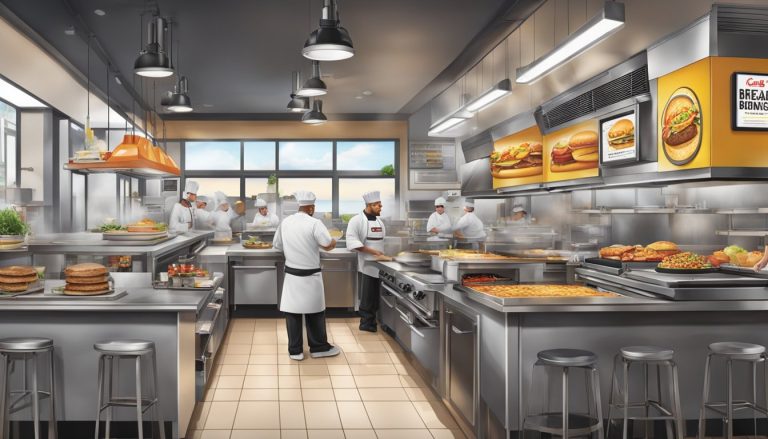Carl’s Jr., a fast-food giant that began as a humble hot dog cart in 1941, has become renowned for its mouthwatering burgers and, perhaps surprisingly, its delectable biscuits. These golden, flaky treats have become a breakfast staple for many loyal customers, leaving them wondering about the secret behind their irresistible texture and taste.
The key to Carl’s Jr.’s biscuit perfection lies in their deceptively simple recipe and meticulous preparation process. These biscuits are made from scratch daily, using a carefully balanced mixture of flour, baking powder, baking soda, salt, and fat, combined with buttermilk to create a tender, flaky texture. The use of high-quality ingredients and precise measurements ensures consistency across all locations.
Another crucial factor in achieving the ideal biscuit is the baking process. Carl’s Jr. bakes their biscuits at a high temperature of 425°F (220°C), which creates a crisp, golden exterior while maintaining a soft, fluffy interior. This attention to detail in both ingredients and technique is what sets Carl’s Jr.’s biscuits apart from the competition, making them a beloved menu item for breakfast enthusiasts nationwide.
The History of Carl’s Jr.
Carl’s Jr. evolved from a single hot dog cart to a major fast-food chain, pioneering innovative menu items like handmade biscuits along the way.
From Humble Beginnings to Fast-Food Giant
Carl Karcher launched Carl’s Jr. in 1941 with a hot dog cart in Los Angeles. He invested $326, using $311 borrowed against his Plymouth car and $15 in savings. The venture proved successful, with first-day sales reaching $14.75.
By 1945, Karcher expanded to a full-service restaurant called Carl’s Drive-In Barbecue in Anaheim, California. The first Carl’s Jr. restaurant opened in 1956, marking the beginning of the chain’s rapid expansion.
Carl’s Jr. quickly became known for innovation in the fast-food industry. In 1977, it became the first chain to install self-serve salad bars in all its California locations.
The Rise of the Biscuit: A Breakfast Staple
Carl’s Jr. continued to innovate with its menu offerings, particularly in the breakfast category. The introduction of handmade biscuits became a cornerstone of their morning menu.
These flaky, freshly-made biscuits set Carl’s Jr. apart from competitors. The chain emphasized the quality and craftsmanship of their biscuits, even as they expanded to thousands of locations.
Carl’s Jr. also led the way with other breakfast innovations. They were among the first fast-food chains to offer a diverse morning menu, helping to establish breakfast as a key part of the fast-food landscape.
The Art of Biscuit Making
Crafting the perfect biscuit requires precision, quality ingredients, and time-honored techniques. Carl’s Jr. has mastered this delicate balance to create their signature flaky biscuits.
Tradition Meets Innovation: The ‘Made From Scratch’ Philosophy
Carl’s Jr. takes pride in their ‘Made From Scratch’ approach to biscuit-making. Each biscuit is handcrafted daily in-store, ensuring freshness and quality. This method combines traditional baking techniques with modern efficiency.
The process begins with carefully measured ingredients. Flour, baking powder, and salt are sifted together to create a light, uniform mixture. Cold butter or shortening is then cut into the dry ingredients using a pastry cutter or by hand.
Buttermilk is gently folded in, creating a soft dough. Care is taken not to overmix, which could result in tough biscuits. The dough is then rolled out and cut into uniform shapes.
Secret Ingredients and Techniques
Carl’s Jr.’s biscuit success lies in their attention to detail and quality ingredients. They use a specific blend of flours to achieve the ideal texture. The fat component is crucial – many speculate they use a combination of butter and shortening for optimal flavor and flakiness.
Temperature control is key. Ingredients are kept cold to prevent the fat from melting prematurely. The oven is preheated to a high temperature, typically around 425°F (220°C). This quick, hot bake creates a golden exterior while maintaining a tender interior.
Another secret may lie in the folding technique. Some bakers fold the dough multiple times, creating layers that contribute to the biscuit’s flakiness. Carl’s Jr. likely employs a similar method to achieve their signature texture.
Nutritional Profile of Biscuits and Breakfast Items

Carl’s Jr.’s biscuits and breakfast items offer a range of flavors but also come with significant caloric content. Understanding their nutritional makeup can help customers make informed choices.
Caloric Content and Health Considerations
The Made From Scratch Biscuit™ at Carl’s Jr. contains 290 calories. It derives 41% of its calories from fat and 51% from carbohydrates. A single biscuit requires about 25 minutes of running or 41 minutes of walking to burn off.
The Bacon, Egg & Cheese Biscuit packs 520 calories per serving. Its calorie breakdown is:
- 51% fat
- 34% carbs
- 15% protein
Many breakfast items at Carl’s Jr. are high in calories. The Breakfast Burger, for example, contains 810 calories, with 370 calories from fat alone.
Balancing Taste with Dietary Needs
Carl’s Jr. offers some lower-calorie options for health-conscious customers. The Grilled Cheese Breakfast Sandwich with Ham has 490 calories, less than many other menu items.
For those with dietary restrictions, it’s important to note that many breakfast items contain common allergens. The Bacon, Egg & Cheese Biscuit includes:
- Egg
- Gluten
- Milk
- Soy
- Wheat
It does not contain fish, peanuts, shellfish, or tree nuts. However, cross-contamination is possible due to shared equipment use.
Vegetarian options are limited in the breakfast menu. Most items contain meat or animal products. Gluten-free choices are also scarce, as biscuits and many breakfast sandwiches contain wheat.
Signature Breakfast Menu Items
Carl’s Jr. offers a diverse breakfast menu featuring hearty options, classic combinations, and innovative creations. Their signature items showcase the restaurant’s commitment to bold flavors and satisfying portions.
Monster Biscuit: A Hearty Option for the Famished
The Monster Biscuit stands out as Carl’s Jr.’s ultimate breakfast sandwich. It packs a flaky biscuit with two sausage patties, two strips of bacon, two folded eggs, and two slices of American cheese.
This hefty sandwich caters to those with big appetites. The combination of meats provides a savory punch, while the eggs add a creamy texture. The cheese melts perfectly, binding all ingredients together.
At around 1,000 calories, the Monster Biscuit is not for the faint of heart. It’s a filling meal that can easily keep customers satisfied until lunch or beyond.
Classic Combinations: Egg, Cheese, and Meat
Carl’s Jr. excels in traditional breakfast sandwiches. Their menu features various combinations of eggs, cheese, and meat on biscuits or croissants.
Popular options include:
- Bacon, Egg & Cheese Biscuit
- Sausage, Egg & Cheese Biscuit
- Ham, Egg & Cheese Croissant
These sandwiches use scrambled eggs, providing a soft texture. American cheese adds a creamy element, while the chosen meat brings a savory flavor.
The biscuit-based sandwiches offer a Southern-inspired taste, with the flaky biscuit complementing the fillings. Croissant options provide a lighter, buttery alternative.
Innovative Delights: Specialty Breakfast Sandwiches
Carl’s Jr. pushes breakfast boundaries with unique offerings. The Breakfast Burger stands out as a signature item, blending breakfast and lunch flavors.
This innovative sandwich features:
- All-beef patty
- Folded egg
- American cheese
- Hash brown nuggets
- Bacon
- Ketchup
Served on a seeded bun, it offers a satisfying combination of textures and tastes. The hash brown nuggets add a crispy element, while the egg brings breakfast flair to a classic burger.
Other specialty items include the Loaded Breakfast Burrito and the Grilled Cheese Breakfast Sandwich. These options cater to customers seeking more adventurous breakfast fare.
Crafting the Flavor Profile

Carl’s Jr.’s biscuits are renowned for their perfect balance of savory, smoky, and sweet notes. The right combination of condiments and add-ons elevates these biscuits from simple side items to culinary masterpieces.
A Deep Dive into Savory, Smoky, and Sweet
Carl’s Jr. biscuits start with a savory base. The dough incorporates butter and buttermilk, creating a rich, tangy foundation. Salt enhances the natural flavors, while a touch of sugar adds subtle sweetness.
The smoky element comes from the cooking process. Biscuits are baked at high temperatures, developing a golden-brown exterior with a hint of char. This imparts a subtle smokiness that complements the savory notes.
To balance the flavors, Carl’s Jr. adds a touch of honey. This natural sweetener enhances the biscuit’s complexity without overpowering the other flavors. The result is a harmonious blend of savory, smoky, and sweet that keeps customers coming back for more.
Condiments and Add-Ons: Enhancing Every Bite
Carl’s Jr. offers a variety of condiments and add-ons to customize their biscuits. The secret sauce is a key player, combining mayonnaise, ketchup, and mustard with proprietary spices. This sauce adds tanginess and depth to each bite.
Bacon is a popular add-on, bringing extra smokiness and saltiness. Its crispy texture contrasts nicely with the soft biscuit. For those who prefer a classic approach, butter is always available.
Carl’s Jr. also offers cheese options. Melted cheddar adds sharpness and creaminess, while pepper jack brings a spicy kick. Eggs can be added for a breakfast-style biscuit, providing protein and a creamy texture.
These condiments and add-ons allow customers to craft their ideal flavor profile, ensuring each biscuit experience is unique and satisfying.
Dietary Adaptations

Carl’s Jr. offers options to accommodate various dietary needs and preferences. Customers can customize menu items and find choices suited to different nutritional requirements.
Options for Vegetarians and Gluten-Sensitive Patrons
Carl’s Jr. provides vegetarian-friendly alternatives for those avoiding meat. The Made from Scratch Biscuit™ is vegetarian when ordered without meat toppings.
For gluten-sensitive individuals, Carl’s Jr. offers some menu items that can be adapted. The Breakfast Burger can be ordered without the bun and wrapped in lettuce instead.
Vegetarian protein options are limited, but sides like Hash Rounds offer a meat-free choice. Carl’s Jr. does not guarantee a gluten-free environment due to shared preparation areas.
Customizing Carl’s Jr. Offerings to Your Diet
Customers can modify menu items to better fit their dietary needs. Removing cheese or switching to egg whites can reduce calorie and fat content.
For a protein boost, extra egg can be added to breakfast sandwiches. The Made from Scratch Biscuit™ contains 290 calories, with options to reduce this by omitting certain toppings.
Nutritional information is available for all menu items. This allows patrons to make informed choices based on their specific dietary requirements or health goals.
Carl’s Jr. accommodates requests for ingredient removals or substitutions when possible, empowering customers to tailor their meals.
Beyond Biscuits: Sides and Accompaniments
Carl’s Jr. offers a variety of sides and accompaniments to complement their famous biscuits. These options range from crispy potatoes to fresh vegetables and signature sauces, providing flavor and texture contrasts to enhance the dining experience.
Hash Browns and Fries: The Perfect Pair
Carl’s Jr.’s hash browns and fries are popular potato-based sides. The hash browns are crispy on the outside and tender inside, ideal for breakfast pairings. They’re often served as round patties, similar to their “hash rounds” offering.
Fries come in different cuts, from classic to crisscut. These golden, crispy fries are seasoned to perfection, offering a satisfying crunch that contrasts nicely with soft biscuits.
Both options are cooked to a golden-brown color and can be enjoyed on their own or paired with dipping sauces for added flavor.
Freshness on the Side: Lettuce, Tomato, and Onion
Fresh vegetables provide a crisp, refreshing contrast to Carl’s Jr.’s hearty biscuits and sandwiches. Crisp lettuce adds a satisfying crunch and light flavor. Ripe tomato slices contribute juiciness and a subtle tang.
Onions, typically available raw or grilled, offer a sharp bite or sweet caramelized taste respectively. These vegetables not only enhance flavor but also add nutritional value to meals.
Carl’s Jr. takes care to ensure these ingredients are fresh and properly stored to maintain quality and food safety standards.
Dipping Delights: Signature Sauces
Carl’s Jr. offers a range of signature sauces to complement their menu items. These may include:
- Classic ketchup
- Tangy barbecue sauce
- Creamy ranch
- Spicy Santa Fe sauce
These sauces can be used for dipping fries, hash browns, or even biscuits. They add flavor variety and allow customers to customize their meals according to personal preferences.
Sauce packets are typically available upon request, giving diners the flexibility to mix and match flavors.
Bread Varieties: Sourdough to Flour Tortilla
While biscuits are a Carl’s Jr. staple, the chain offers other bread options to cater to diverse tastes. Sourdough bread provides a tangy flavor and chewy texture, often used for breakfast sandwiches or burgers.
Flour tortillas offer a softer, more flexible option. They’re commonly used for wraps or breakfast burritos, providing a different texture experience from traditional biscuits or buns.
These bread alternatives allow Carl’s Jr. to expand their menu offerings and appeal to customers seeking variety in their meals.
Operational Excellence
Carl’s Jr. has honed its biscuit-making process to achieve consistent quality and efficiency. The company’s operational excellence encompasses streamlined kitchen workflows and rigorous quality control measures.
Efficient Kitchen Practices and Customer Service
Carl’s Jr. employs a well-organized kitchen layout to optimize biscuit production. Dedicated stations are equipped with specific tools and ingredients for each step of the process. Staff receive thorough training on proper mixing, shaping, and baking techniques. Timers and temperature monitors ensure precise cooking times and temperatures.
The kitchen’s workflow is designed to maintain a steady output of fresh biscuits throughout peak hours. A rotating baking schedule keeps warm biscuits available for immediate service. This efficiency extends to the front counter, where staff are trained to quickly assemble biscuit sandwiches and serve customers promptly.
Quality Assurance: Delivering Consistency
Carl’s Jr. implements strict quality control measures to maintain biscuit consistency across all locations. Each batch is visually inspected for proper color, size, and texture. Random samples undergo taste tests to verify flavor and texture meet company standards.
The fast-food restaurant uses standardized recipes and pre-measured ingredient kits to ensure uniformity. Regular audits and surprise inspections help maintain adherence to cooking processes and quality standards. Staff receive ongoing training and performance evaluations to reinforce proper biscuit-making techniques.
Feedback mechanisms, including customer surveys and secret shopper programs, provide valuable insights for continuous improvement. This commitment to quality assurance helps Carl’s Jr. deliver consistently flaky, delicious biscuits that customers have come to expect.




